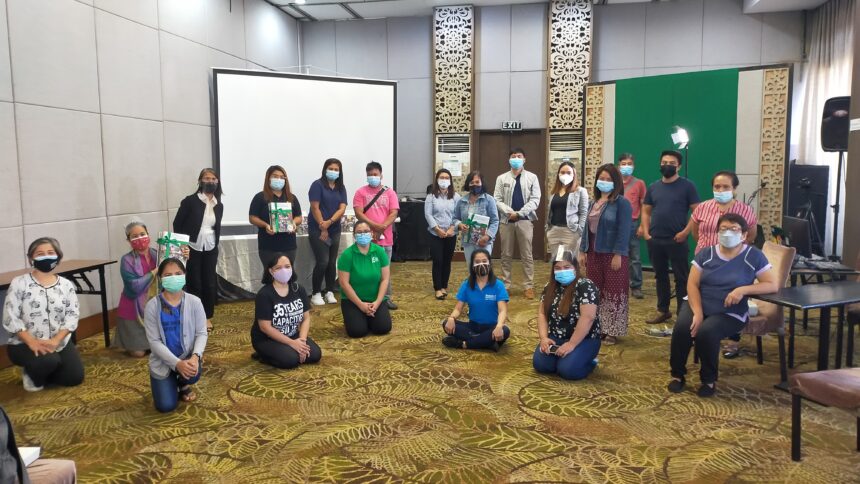Community-based Disaster Management Conference 2021: “During the COVID-19 Pandemic: Gaining Strength while Overcoming New Challenges”
The Citizens’ Disaster Response Center Foundation Inc. (CDRC) recently convened a National Conference on Community-based Disaster Management (CBDM) titled “During the COVID-19 Pandemic: Gaining Strength while Overcoming New Challenges.” It was held on June 05, 2021, at the Cocoon Boutique Hotel in Quezon City. The Conference aimed to demonstrate the achievements and challenges faced by the Regional Centers (RCs) of the Citizens’ Disaster Response Network (CDRN) during the implementation of the Enhancing capacities of RCs and CDRN in disaster risk management for more resilient people and communities in the Philippines Phase 2 (ENCAP 2) project. It also featured how the Regional Centers’ effectively practiced community resilience and adapted CBDM practices during the COVID-19 pandemic.
The National Conference was a hybrid gathering spearheaded by CDRC as the Secretariat of CDRN. The event was truly a milestone not only in recognizing the importance of mainstreaming CBDM but was also a breakthrough in bringing together more than 300 attendees across the islands of Luzon, Visayas, and Mindanao through an online medium and limited number of face to face attendees. The main participants were from CDRN’s 11 Regional Centers and their Disaster Preparedness Committees (DPC). The attendees also included a wide range of stakeholders from local government units, community representatives, NGOs, the private sector, and other civil society organizations.
Deputy Administrator for Administration, Asec. Hernando Caraig Jr., from the Office of Civil Defense (OCD) foregrounded the important role of Community-based Disaster Risk Reduction and Management in disaster preparedness and response. “Bear in mind that building a more resilient community requires collective effort,” he said. Asec. Caraig then lauded the efforts of CDRC in promoting community-based disaster management while stressing the importance of collaboration and cooperation among the relevant agencies to help the country attain its goal of resilience.
CBDM Good Practices
After the keynote message, the good practices of the Regional Centers on mainstreaming community-based disaster management was featured. The RCs were the Disaster Response Center (DIRECT) and Mindanao Interfaith Services Foundation, Inc. (MISFI) from Mindanao; Panay Center for Disaster Response (PCDR) and Leyte Center for Development (LCDe) from Visayas; Tarabang para sa Bicol, Inc. (TABI), Alay Bayan Luson, Inc. (ABI), Cordillera Disaster Response and Development Services, Inc. (CorDisRDS), Ilocos Center for Empowerment and Development (ICRED), Cagayan Valley Disaster Response Center (CVDRC), Southern Tagalog People’s Response Center (STPRC), and Community Response for Enlightenment, Services and Transformation (CREST) from Luzon. Through video documentation, each of the RCs, along with their formed Disaster Preparedness Committee, shared their initiatives in the field of disaster risk reduction, stories of community resilience, and the practices they adopted in building the capacities of their communities in mitigating the threats brought by disasters while overcoming the challenges posed by the current pandemic. This part in the Conference emphasized the importance of documenting grassroots practices so that the knowledge can be disseminated to more community members and DRR advocates. The shared stories also illustrated the significance of collective action as exercised by the RCs and their served communities. It also emphasized the importance of providing basic community-based disaster management at the community level. The active participation of the community in the implementation of the project confirms their strong commitment to building community resilience.
Aside from the sharing of good practices, the DPC members also suggested ways forward on how CBDM can further be improved and applied to their communities. They conveyed how plans need to be enriched, scaled-up, and sustained even after the EnCap 2 project has been completed.
CBDM Manual Book Launching
The Conference also highlighted the book launching of the second edition of “Manwal ng Pagsasanay: Nakabatay sa Komunidad na Pangangasiwang Pansakuna (NKPP) (Community-based Disaster Management). This handbook is a compilation of CDRC’s enriched experiences and learnings derived from thirty -five years of close collaboration with communities, institutions, and local governments since 1984 in preparing and responding to various forms of disasters.
Two digitized IEC (information, education, and communication) materials were also shared during the Conference. These animated videos explained the importance of hazard mapping which helps the community to recognize its resources, capacities, and disaster-prone areas.
All the participants highly commended the Conference and expressed their desire in continuing to hold such an event. Hopefully, the successful experience shared made the Conference more relevant and will serve as a guide in future practice of communities in reducing disaster risks.

